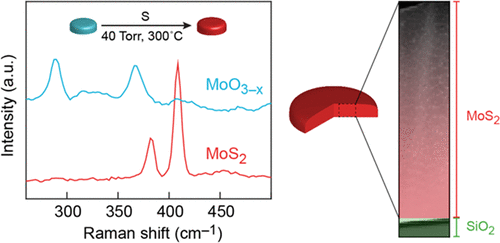当前位置:
X-MOL 学术
›
ACS Appl. Electron. Mater.
›
论文详情
Our official English website, www.x-mol.net, welcomes your feedback! (Note: you will need to create a separate account there.)
Chalcogen Incorporation Process during High-Vacuum Conversion of Bulk Mo Oxides to Mo Dichalcogenides
ACS Applied Electronic Materials ( IF 4.7 ) Pub Date : 2020-03-03 , DOI: 10.1021/acsaelm.0c00063 Erick C. Sadler 1 , Thomas J. Kempa 1, 2
ACS Applied Electronic Materials ( IF 4.7 ) Pub Date : 2020-03-03 , DOI: 10.1021/acsaelm.0c00063 Erick C. Sadler 1 , Thomas J. Kempa 1, 2
Affiliation

|
The optical, electronic, catalytic, and mechanical properties of transition-metal dichalcogenide (TMD) bulk crystals and monolayers have been examined extensively. TMD materials can be prepared through exfoliation, deposition from elemental and molecular precursors, and chemical conversion of corresponding transition metal oxides. Nevertheless, approaches for large-scale synthesis of high-quality TMD crystals are needed to ensure the continued utilization of these materials within optoelectronic and energy conversion applications. Moreover, studies examining the principal stages of TMD nucleation and growth are comparatively rare and require further attention. We report a method for the conversion of bulk MoO3 to MoX2 (X = S, Se) under high-vacuum conditions and use this approach to isolate and examine intermediates formed during the chalcogenation process. Micron-scale Mo sub-oxide deposits are readily converted to MoS2 when exposed to an atmosphere of S at 40 Torr and 300 °C. Notably, we show through elemental mapping of the cross-section of a partially converted single deposit that MoS2 is present at higher concentrations nearest the deposit–substrate interface. We also note the formation of either distinct or alloyed TMD phases depending on whether a stepwise or concurrent chalcogenation, respectively, is performed. Our results provide an effective route toward conversion of transition metal oxides to bulk TMDs and provide insights into the mechanism of this scalable conversion process.
中文翻译:

大量Mo氧化物向Mo Dichalcogenides的高真空转化过程中的硫族元素掺入过程
过渡金属二硫化氢(TMD)块状晶体和单分子层的光学,电子,催化和机械性能已得到广泛研究。TMD材料可以通过剥离,从元素和分子前体中沉积以及相应的过渡金属氧化物的化学转化来制备。尽管如此,仍需要大规模合成高质量TMD晶体的方法,以确保在光电和能量转换应用中继续利用这些材料。而且,检查TMD成核和生长主要阶段的研究相对较少,需要进一步关注。我们报告了将大量MoO 3转换为MoX 2的方法(X = S,Se)在高真空条件下使用此方法来分离和检查硫属元素化过程中形成的中间体。当暴露在40 Torr和300°C的S气氛中时,微米级的Mo次氧化物沉积物很容易转化为MoS 2。值得注意的是,我们通过对部分转化的单个沉积物的横截面进行元素映射,表明MoS 2以最接近沉积物-底物界面的较高浓度存在。我们还注意到,是分别执行逐步硫磺化还是同时进行硫磺化,分别形成不同的TMD相或形成合金TMD相。我们的结果为过渡金属氧化物向大体积TMD的转化提供了有效途径,并为这种可扩展转化过程的机理提供了见识。
更新日期:2020-03-03
中文翻译:

大量Mo氧化物向Mo Dichalcogenides的高真空转化过程中的硫族元素掺入过程
过渡金属二硫化氢(TMD)块状晶体和单分子层的光学,电子,催化和机械性能已得到广泛研究。TMD材料可以通过剥离,从元素和分子前体中沉积以及相应的过渡金属氧化物的化学转化来制备。尽管如此,仍需要大规模合成高质量TMD晶体的方法,以确保在光电和能量转换应用中继续利用这些材料。而且,检查TMD成核和生长主要阶段的研究相对较少,需要进一步关注。我们报告了将大量MoO 3转换为MoX 2的方法(X = S,Se)在高真空条件下使用此方法来分离和检查硫属元素化过程中形成的中间体。当暴露在40 Torr和300°C的S气氛中时,微米级的Mo次氧化物沉积物很容易转化为MoS 2。值得注意的是,我们通过对部分转化的单个沉积物的横截面进行元素映射,表明MoS 2以最接近沉积物-底物界面的较高浓度存在。我们还注意到,是分别执行逐步硫磺化还是同时进行硫磺化,分别形成不同的TMD相或形成合金TMD相。我们的结果为过渡金属氧化物向大体积TMD的转化提供了有效途径,并为这种可扩展转化过程的机理提供了见识。


























 京公网安备 11010802027423号
京公网安备 11010802027423号